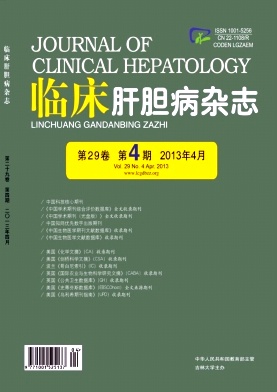|
[1]Liver Failure and Artificial Liver Group, Chinese Society of In-fectious Diseases, Chinese Medical Association;Severe Liv-er Diseases and Artificial Liver Group, Chinese Society ofHepatology, Chinese Medical Association.Diagnostic andtreatment guideline for liver failure[J].Chin J Intern Med, 2006, 45 (12) :1053-1056. (in Chinese) 中华医学会感染病学分会肝衰竭与人工肝学组、中华医学会肝病学分会重型肝炎与人工肝学组.肝衰竭诊疗指南[J].中华内科杂志, 2006, 45 (12) :1053-1056.
|
|
[2]Laleman W, Verbeke L, Meersseman P, et al.Acute-on-chronic liver failure:current concepts on definition, patho-genesis, clinical manifestations and potential therapeutic in-terventions[J].Expert Rev Gastroenterol Hepatol, 2011, 5 (4) :523-537.
|
|
[3]Karvellas CJ, Pink F, Austin MJ, et al.Bacteremia, APACHEⅡand MELD are independent predictors of mortility in critically illpatients with acute-on-chronic liver failure[J].Hepatology, 2008, 48 (4) :515A.
|
|
[4]Zheng MH, Ye C, Shi KQ, et al.Comparison of MELD, Mayo, MESO, CTP and MELD-Na scores for predicting 3-monthmortality in patients with acute-on-chronic hepatitis B liverfailure[J].Int J Infect Dis, 2010, 14 (suppl 2) :S19.
|
|
[5]Sen S, Mohseni S, Sjodin L, et al.Baseline SOFA score andits lack of early improvement accurately predicts mortality inpatients with acute-on-chronic liver failure[J].Hepatolo-gy, 2004, 40 (4) :498A.
|
|
[6]Duan ZP, Chen Y.Recent progress and future perspectivesof liver failure diagnosis and treatment strategies[J].J ClinHepatol, 2012, 28 (10) :721-725. (in Chinese) 段钟平, 陈煜.肝衰竭诊疗:进展与展望[J].临床肝胆病杂志, 2012, 28 (10) :721-725.
|
|
[7]Ye PY, Miao H, Yang ZG, et al.Clinical observation on chro-nic severe hepatitis at early-middle stage treated with reten-tion enema of JieDu ZhuyuFang[J].Western J Tradit ChinMed, 2012, 25 (7) :1-3. (in Chinese) 叶佩燕, 苗慧, 杨宗国, 等.解毒逐瘀方保留灌肠治疗早中期慢性重型肝炎患者的临床观察[J].西部中医药, 2012, 25 (7) :1-3.
|
|
[8]Cao H, Tan SZ, Xie BH, et al.Analysis of the therapeuticeffect of elevation of retention enema of herbal drugs by se-quential colon dialysis on in patients with acute on chronichepatic failure[J].J Clin Hepatol, 2011, 27 (5) :485-487. (in Chinese) 曹慧, 谭善忠, 谢碧红, 等.结肠透析机中药高位保留灌肠治疗慢性乙型肝炎肝衰竭早期的疗效分析[J].临床肝胆病杂志, 2011, 27 (5) :485-487.
|
|
[9]Zhang DQ, Chen L, Gan QR, et al.Prognostic factors forhepatitis B acute-on-chronic liver failure[J].J Clin Hepa-tol, 2012, 28 (10) :740-743. (in Chinese) 张冬青, 陈立, 甘巧蓉, 等.乙型肝炎相关慢加急性肝衰竭患者的预后因素分析[J].临床肝胆病杂志, 2012, 28 (10) :740-743.
|
|
[10]Hong L, Ye ZY, Sun QF, et al.Relationship between com-plications and prognosis of acute-on-chronic hepatitis Bliver failure[J].Chin J Microecology, 2011, 23 (9) :829-831. (in Chinese) 洪亮, 叶志勇, 孙庆丰, 等.慢加急性乙型肝炎肝衰竭并发症与预后的关系研究[J].中国微生态学杂志, 2011, 23 (9) :829-831.
|
|
[11]Tang WL, Zhao DG, Dong ZX, et al.Prognostic risk factorsand prognosis model for liver failure[J].Infect Dis Inf, 2011, 24 (3) :159-162. (in Chinese) 汤伟亮, 赵德钢, 董志霞, 等.肝衰竭预后危险因素及预后模型建立的研究[J].传染病信息, 2011, 24 (3) :159-162.
|
|
[12]Yuen MF, Sablon E, Hui CK, et al.Prognostic factors in se-vere exacerbation of chronic hepatitis B[J].Clin Infect Dis, 2003, 36 (8) :979-984.
|
|
[13]Chien RN, Lin CH, Liaw YF, et al.The effect of lamivudinetherapy in hepatic decompensation during acute exacerbation ofchronic hepatitis B[J].J Hepatol, 2003, 38 (3) :322-327.
|
|
[14]Tsubota A, Arase Y, Suzuki Y, et al.Lamivudine monotherapyfor spontaneous severe acute exacerbation of chronic hepatitisB[J].J Gastroenterol Hepatol, 2005, 20 (3) :426-432.
|
|
[15]Cazzaniga M, Dionigi E, Gobbo G, et al.The systemic in-flammatory response syndrome in cirrhotic patients:relation-ship with their in-hospital outcome[J].J Hepatol, 2009, 51 (3) :475-482.
|













 DownLoad:
DownLoad: